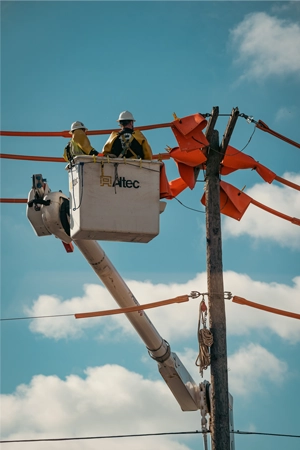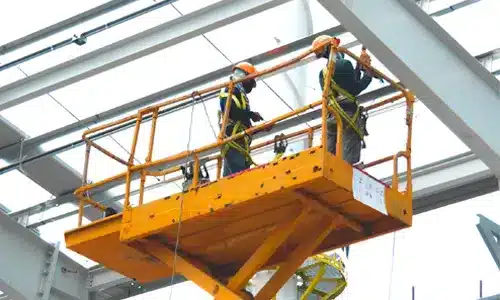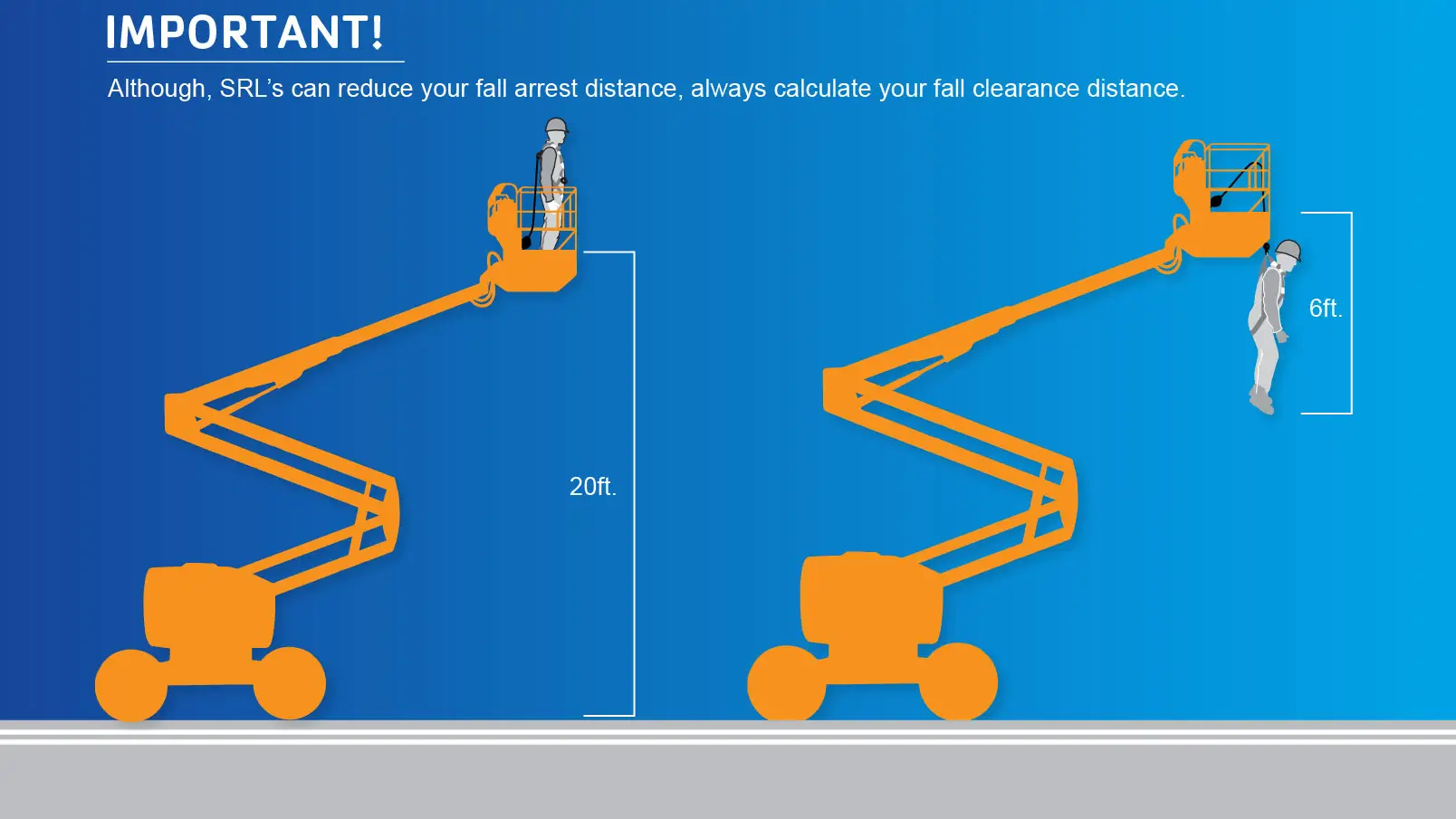Your cart is currently empty!
The Ultimate Guide to Fall Protection in Aerial Lifts!
When it comes to working at heights, ensuring proper fall protection is crucial for the safety of workers. Whether you’re operating an aerial lift or a scissor lift, understanding the fall protection requirements is essential to keep yourself and your team safe. In this comprehensive guide, we’ll explore the necessary fall protection measures for both aerial lifts and scissor lifts. In this article, we will explain some of the challenging factors associated with this application, and help you navigate these regulations like a pro.
Understanding Fall Protection Requirements for Aerial and Scissor Lifts
The Occupational Safety and Health Administration (OSHA) has established specific standards for fall protection in aerial lifts and scissor lifts. Before we delve into the fall protection requirements, let’s briefly differentiate between aerial lifts and scissor lifts:

- Aerial Lifts: Aerial lifts, also known as boom lifts or cherry pickers, consist of a hydraulic arm or boom with a platform at the end. This allows for both vertical and horizontal movement, making them suitable for tasks that require extended reach, such as working on building exteriors or in outdoor settings.

- Scissor Lifts: Scissor lifts are vertically elevated work platforms with a scissor-like mechanism that raises and lowers the platform. They typically provide vertical movement and are commonly used for flat surface applications. Scissor lifts have a larger platform but limited horizontal reach.
Fall Protection Requirements for Aerial Lifts
When it comes to working with aerial lifts, safety should always be the top priority. Following OSHA’s guidelines is crucial to ensure the well-being of workers at elevated heights. OSHA’s standard for fall protection in aerial lifts emphasizes the importance of taking appropriate measures to protect workers in these situations. According to OSHA, employees are required to wear a “personal fall arrest system” (PFAS) when working from a boom lift.
Aerial lifts come with their own unique set of risks due to their elevated baskets or buckets. The very nature of these lifts exposes workers to the potential danger of being ejected from the basket during operation. This risk highlights the significance of implementing strong fall protection measures to safeguard workers and prevent falls and related injuries. OSHA’s requirement for the use of personal fall arrest systems aims to minimize the chances of accidents and foster a safe working environment.
Fall Protection Requirements for Scissor Lifts
While scissor lifts and aerial lifts share some fall protection requirements, there are differences to consider. The primary distinction lies in the presence of guardrails. Scissor lifts typically have larger work platforms with standard guardrails, providing a level of passive fall protection. OSHA requires all scissor lifts to have guardrails in place. These guardrails must be properly installed, well-maintained, and meet specific height standards set by regulatory guidelines.
While guardrails are the primary form of fall protection for scissor lifts, additional fall protection measures may be required in certain circumstances. Factors such as working near edges or openings, transitioning off of the platform, or performing tasks that increase the risk of falls may necessitate the use of personal fall arrest systems (PFAS) as an added precaution. It is essential to assess the specific work environment and tasks involved to determine if additional fall protection measures are necessary.
Understanding the Differences
While both aerial lifts and scissor lifts require fall protection, there are distinct differences in their design and requirements. Aerial lifts provide both vertical and horizontal movement, necessitating additional measures to ensure worker safety. Scissor lifts, on the other hand, typically have larger work platforms and rely on standard guardrails as the primary means of fall protection.
Although the presence of guardrails on a scissor lift satisfies the minimum requirements defined by OSHA, it is highly advised by FrenchCreek that personal fall protection equipment be used at all times when operating a scissor lift. While guardrails provide a significant level of safety, there are situations where additional fall protection measures may be necessary. It is the duty of employers to thoroughly evaluate the unique work conditions and carefully assess whether additional measures for fall protection are required when operating scissor lifts.
Why Fall Protection Standards For Aerial Lifts Can Be Tricky
Understanding and complying with fall protection standards for aerial lifts and scissor lifts can present certain challenges due to the unique nature of working on an elevated work platform. Examples of these challenges include:
- Diverse Work Environments: Aerial lifts are mobile platforms that can be maneuvered to different locations, making fall protection more complex. As the lift moves, the surrounding work environment changes, presenting unique challenges in maintaining consistent fall protection systems. Workers need to adapt and ensure continuous protection throughout the lift’s operation.
- Varied Lift Designs: Aerial lifts and scissor lifts come in various designs, each with its own fall protection requirements. Understanding the intricacies of different lift designs is crucial for compliance and effective protection. In certain cases, older models of aerial lifts might lack the necessary fall protection anchorage points, which means they may not meet the requirements for a reliable fall protection system. However, it’s worth noting that the majority of modern aerial lifts, which are widely used today, are equipped with appropriate anchor points and designated locations to ensure the proper implementation of fall protection measures.
- Considering & Calculating Fall Clearance Distance: Properly calculating fall clearance distance is undoubtedly one of the most crucial and intricate aspects when working on an aerial lift. According to OSHA guidelines, fall protection is mandatory at heights of six feet or more on an aerial lift. However, complexity arises when dealing with lower fall clearance levels. For instance, if an aerial lift is only elevated to a height of 10 feet, a standard 6-foot shock-absorbing lanyard may not be sufficient to arrest the fall quickly enough to prevent the worker from making contact with the ground. It becomes imperative to ensure the use of appropriate equipment that is specifically designed to safeguard workers at lower clearance levels, thereby prioritizing their safety and well-being. For lower clearance levels, FrenchCreek recommends the utilization of a self-retracting line with quick fall arrest capabilities, such as our Rogue Series Self-Retracting Lifelines. These lightweight units enable workers to remain mobile on the work platform while ensuring enhanced safety. With a maximum arresting distance of up to 24 inches, these self-retracting lifelines significantly reduce the total fall distance in comparison to a shock-absorbing lanyard. By employing these advanced lifelines, workers can work confidently at lower heights, knowing that they are equipped with effective fall protection measures. Make sure to check out our other article that provides detailed guidance on accurately calculating fall clearance distance. It offers valuable insights and practical tips to ensure the safety and compliance of workers in various fall protection scenarios.
Please take a moment to review the diagrams below, which serve as a reference for understanding the concepts discussed.


Can I use a Body Belt In An Aerial Lift?
There has been a considerable amount of confusion regarding the use of body belts in aerial lifts. According to the OSHA regulation, it is stated that users should wear a body belt and securely attach a lanyard to the boom or basket. However, it is important to note that starting from January 1, 1998, subpart M of section 1926.502(d) specifies that body belts are no longer considered acceptable as part of a personal fall arrest system. It is crucial to understand that the use of a body belt in a tethering system or restraint system, on the other hand, is still permissible and regulated under section 1926.502(e). The key point to emphasize is the distinction between restraint and fall arrest measures:
- Fall restraint prevents a worker from reaching the fall hazard, thus eliminating the possibility of a fall altogether.
- Fall arrest is designed with the purpose of safeguarding workers in the event of a fall by effectively stopping their descent.
While the use of a body belt for positioning and restraint is still permitted in aerial lifts, it is important to note that FrenchCreek always advocates for the use of a full-body harness. This is because restraint systems, when not used properly, can increase the risk of a fall. Opting for a fall arrest harness significantly enhances safety compared to relying solely on a body belt. The full-body harness provides superior protection, distributing the forces of a fall across the body, reducing the risk of injury, and ensuring the utmost safety for workers operating in aerial lifts.
Final Thoughts
Maintaining adequate fall protection measures is of utmost importance when working at elevated heights, be it on aerial lifts or scissor lifts. By familiarizing yourself with the specific fall protection requirements for each type of lift, adhering to OSHA guidelines, and utilizing suitable fall arrest devices, you can effectively ensure the highest level of safety for both yourself and your team. It is crucial to stay updated on the latest standards, seek expert advice when necessary, and prioritize the well-being of all individuals involved.
Always remember that fall protection is an ongoing process that demands continuous evaluation and implementation. Remain vigilant, prioritize safety at all times, and create a secure working environment for everyone. For further information or any inquiries, feel free to reach out to our knowledgeable FrenchCreek training staff, or contact us at 877.229.937. Stay proactive and stay safe!